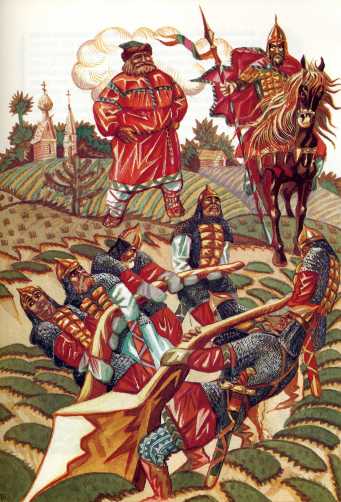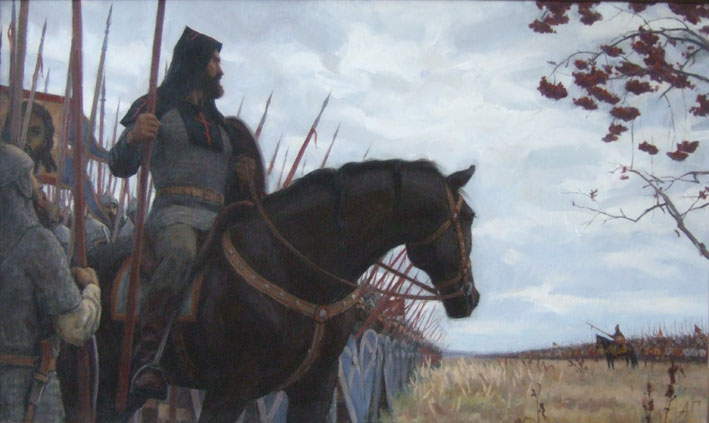Bogatyrs
With Christianity becoming widespread, a new legendarium appeared in the Rus – the tales of Bogatyrs, heroic warriors who protected the land from beasts, monsters, and invading steppe nomads. The lays about Bogatyrs are called byliny (a nigh-untranslatable Old Russian word roughly meaning “the stories that did happen”; they are not to be confused with bliny, which are delicious pancakes)note . Many legendary Bogatyrs were indeed historical persons (the most well known one, Ilya Muromets, who was a Russian Orthodox saint). But more obscure legends tell about fictional or even non-human Bogatyrs, such as the giant Svyatogor or the dog-headed Polkan, whose name is a popular dog name in modern Russia. Legends often place Bogatyrs in the court of Prince Vladimir I, much like the knights of King Arthur, ignoring the fact that the historical Bogatyrs lived in different times and could not have met (heck, they could not even call themselves Bogatyrs, because they lived long before the first encounter of Russians with Turkish tribes of polovets. The original slavonic word is horobr).Notable Bogatyrs include:
Svyatogor
- An ancient Bogatyr of tremendous height and power, which proves too much for Mother Earth, so he has to move into the mountains to avoid sinking into the ground. He often plays the Older and Wiser mentor role to younger Bogatyrs, especially, Ilya Muromets.
Ilya Muromets
- (“Ilya from Murom”). Regarded as the most badass among the Bogatyrs, Ilya spends the first 33 years of his life half-paralyzed, until one day, two pilgrims heal him and send him off to kick ass. In addition toSuper Strength he “inherits” fromSvyatogor, Ilya relies on common sense and combat tactics to defeat many an enemy.
- Is probably a conflation of several historical characters like a warrior monk and an Orthodox Saint Ilia Pechersky (Elijah of the Caves), who’s still interred in a Kievo-Pechersky Monastery, but who lived a couple of centuries after Vladimir I’s time, and Dobrynya Malovich, Vladimir’s maternal uncle, tutor, general and chief minister during his reign, who himself became a famous bogatyr.
- This one was adapted into a film
 in the 50’s by the USSR. Although far from bad, a… somewhat imperfect translation would later show up on MST3K.
in the 50’s by the USSR. Although far from bad, a… somewhat imperfect translation would later show up on MST3K. - There it touches German/Norse Mythology, where supposedly the same Ilya appears as the father of Hartnit (or Ortnit). According to one saga, Ortnit ruled in Holmgard (Novgorod) and won in an Engagement Challenge for a Valkyrie. Which may be a reference to the time when a tribe of German or Scandinavian descent called “Rus” half-conquered half-assimilated into its Slavic neighbours, turning into something new.
- Hartnit is also mentioned in Thidreks Saga: Mimir gave to Sigurd (as an apology for trying to kill him) the armor he made for Hartnit of Holmgard.
Dobrynya Nikitich
- A Cultured Warrior from Ryazan who proves himself a Worthy Opponent to Ilya Muromets himself and sports a “rap sheet” almost as extensive as Ilya’s. Is based on a historical figure of the same name, despite also being one of the prototypes of Ilya, though his father (and Vladimir’s maternal grandfather) was named Mal (a small one), not Nikita, in Real Life. Was probably subject to the same persecution as Vladimir himself, because his sister, Malusha, was a Princess Olga’s favourite housekeeper, a slave’s position in the Kievan Rus, so he had all the reasons to support his nephew.
- His and Malusha’s father, Mal (or Malk) Lyubechanin, was apparently a foreigner to the Kievan court — either a German (as his Lyubechanin — one of Lubek — appelation suggests) or, as some historian claims, a Drevlyan chieftain, Drevlyans being the main rivals of the Polyans, a Slavic tribe living around Kiev. This, and the fact that he was probably a prisoner of war (and thus a slave), can explain the condescending attitude that Kievans had to their family, which forced Vladimir and Dobrynya to became The Chessmasters they were.
Alyosha Popovich
- Born in Rostov in a clergy family (“Popovich” literally means “son of priest”), he is a Trickster Archetype among the Bogatyrs, who rounds up the famous Power Trio with Ilya and Dobrynya.
Volha Vseslavovich
- (Svyatoslavovich in some versions). A Magic Knight and a Shape Shifter, he scores a preventive strike against the Indian King, saving Rus from his impending invasion.
Mikula Selyaninovich
- (“Mikula the Villager’s son”). Of common descent, he nevertheless possesses the sheer strength of Mother Earth herself, making him even stronger physically than Svyatogor. There’s also a ballad in which Volha met and befriended him, and was quite impressed, especially when several of his men failed to lift a golden plow Mikula lifted with one hand. Other than that, however, he didn’t earn much fame. With all his strength he’s a ploughman, not a warrior.
Mikhailo Potyk
- The Boisterous Bruiser and The Big Guy, who, for example, wins Bukhara Kingdom… in a game of checkers with its Khan.
Princess Nastasya of Lithuania
- One of the few female Bogatyrs you’ll find (normally, women play eitherantagonistic or trusty adviser roles in byliny), she is an exceptional Archer but is accidentally killed by her own husband.
- Sokolnik. Ilya’s bastard son who tries to kill him but fails.
- Some versions (and the aforementioned movie) have him surviving. Also, in another story he is replaced by Ilya’s daughter, who, after the Luke, I Am Your Father moment, attempts to murder Ilya in his sleep… because, according to him, she is an illegitimate child.
Vasilisa Mikulichna
- Vasilisa Mikulichna, another female warrior. She came disguised as a man to Prince Vladimir’s court to claim her husband Stavr from Vladimir’s prison, then dared his best warriors and bested them, then passed a wit contest, and then won the riddle game, finally getting her husband back as part of a bet made by the Prince. In addition, her riddle was of a very erotic flavour; it told about the game of a silver spike and golden ring, so no wonder that only Stavr could solve it. By her patronimic, she may be considered as a daughter of Mikula Selyaninovich.
Alexander Peresvet
- Alexander Peresvet. A semi-historical, rather than legendary, Warrior Monk who participated in the Battle of Kulikovo.
Ilya Muromets, Alyosha Popovich and Dobrynya Nikitich are the most well known Bogatyrs and, in modern depictions are often shown as a team of three. Early stories, however, did NOT differentiate the Bogatyrs into the “famous trio” and “everyone else” the way modern stories are likely to do. One possible reason for the change is the Three Bogatyrs painting![]() ◊.
◊.
Source:











An impressive array of legendary/semi-historical characters, with some interesting and exciting stories between them! I rather like the idea of the trio of Bogatyrs: strength in numbers and all that. 🙂
Very interesting post with some great illustrations.
Thanks